
In this VFR - GPS Flight Plan we take off from the airport of Axum (HAAX) [Ethiopia], fly to the east, overfly the Karum and Afrera lakes and finally land in the airport of Semera (HASM) [Ethiopia]
At the bottom of this page you will find the download link of this Flight Plan (.PLN file)

In this VFR - GPS Flight Plan we take off from
the airport of Axum (HAAX) [Ethiopia], fly to the east, overfly the
Karum and Afrera lakes and finally land in the airport of Semera (HASM)
[Ethiopia]
Find below a short extract and screenshots of the main points of the route. In this journey around Africa I have used the Cessna 172S (Skyhawk)

Take off from the runway 34 of the airport of Axum.
Axum Airport (IATA: AXU, ICAO: HAAX), also known as Emperor Yohannes IV Airport, is an airport serving Axum, a city in the northern Tigray Region of Ethiopia. The name of the city and airport may also be transliterated as Aksum. The facility is located 5.5 km (3.4 miles) to the east of the city.
The airport is named after Yohannes IV, the Emperor of Ethiopia from 1872 to 1889.
The airport was heavily damaged by Tigray People's Liberation Front forces during the Tigray conflict in November 2020.
Axum Airport resides at an elevation of 2,108 metres (6,916 ft) above mean sea level. It has one runway designated 16/34, with an asphalt concrete surface measuring 2,400 by 45 metres (7,874 ft × 148 ft).[1] It is capable of receiving very large aircraft, such as the Antonov 124, which brought the Axum Obelisk back from Italy in 2005. (*1)

After turning right we say goodbye to Axum flying towards
the lakes.

Overflying Adigrat.
Adigrat (also called Addi Grat) is a city and separate woreda in Tigray Region of Ethiopia. It is located in the Misraqawi Zone at longitude and latitude 14°16′N 39°27′ECoordinates: 14°16′N 39°27′E, with an elevation of 2,457 metres (8,061 ft) above sea level and below a high ridge to the west. Adigrat is a strategically important gateway to Eritrea and the Red Sea. Adigrat was part of Ganta Afeshum woreda before a separate woreda was created for the city. Currently, Adigrat serves as the capital of the Eastern Tigray zone.
Adigrat is one of the most important cities of Tigray, which evolved from earlier political centers and camps of regional governors. Antalo, Aläqot and Adigrat were a few of them. The decline of Antalo was followed by the rise of Adigrat as another prominent, yet short-lived, capital of Tigray. It used to serve as the capital of Agame. (*1)
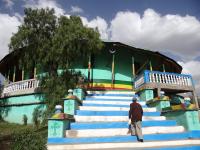 |
 |
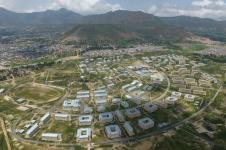 |
| Adigrat
Chirkos Church By Adam Jones - CC BY-SA 2.0 |
Cathedral of the Holy
Saviour By Sailko - CC BY 3.0 |
The Adigrat University
grounds By Turtlewong - CC BY 4.0 |

Leaving behind the mountain range.

Approaching Dallol.
Dallol is a unique, terrestrial hydrothermal system around a cinder cone volcano in the Danakil Depression, northeast of the Erta Ale Range in Ethiopia. It is known for its unearthly colors and mineral patterns, and the very acidic fluids that discharge from its hydrothermal springs.
Dallol mountain has an area of about 3 by 1.5 km (1.9 by 0.9 mi), and rises about 60 m (196.9 ft) above the surrounding salt plains. A circular depression near the centre is probably a collapsed crater. The southwestern slopes have water-eroded salt canyons, pillars, and blocks. There are numerous saline springs and fields of small fumaroles.
Numerous hot springs discharge brine and acidic liquid here. Small, widespread, temporary geysers produce cones of salt. The Dallol deposits include significant bodies of potash found directly at the surface. The yellow, ochre and brown colourings are the result of the presence of iron and other impurities. Older, inactive springs tend to be dark brown because of oxidation processes. (*1)
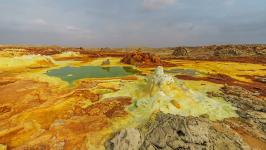 |
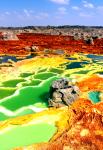 |
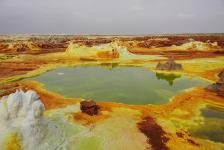 |
| Landscape at Dallol volcano By A.Savin |
Colorful hydrothermal pools
and terraces of Dallol By Kotopoulou Electra - CC BY-SA 4.0 |
Sulfur ponds By A.Savin |

Salt deposits in the salt
lake Karum.
Lake Karum (also known as Lake Assale or Asale) is a salt lake in the Afar Region of Ethiopia. One of two salt lakes in the northern end of the Danakil Depression (the other one being Lake Afrera), it lies at -120m (-394ft) relative to sea level. The volcano Erta Ale rises southeast of this lake.
Werner Munzinger, who traveled through the Afar Depression in 1867, recorded that this lake was fed by four streams: The Didic, the Ala, the Rira Guddy, and the Ragali or Awra, which is the only permanent stream flowing into Lake Karum.
North of Lake Karum is the former mining-settlement of Dallol. The lake is extremely salty and is surrounded by a salt-pan, which is still mined. The salt is transported by caravan to the rest of the country. (*1)

Leaving lake Karum behind.

Approaching lake Afrera.
From there we fly southwards until the small unmanned aerodrome of
Semera (HASM) where we'll land in the dust runway 13.
Lake Afrera (in Italian Lake Giuletti) is a hypersaline lake in northern Ethiopia. Located in Kilbet Rasu, Afar Region, it is one of the lakes of the Danakil Depression. According to its entry in Lakenet, it has a surface area of 100 km2 (39 sq mi), although another source states the area is 125 km2 (48 sq mi). An unconfirmed report gives its depth as 160 m (525 ft); the lake is fed by underground streams.
It is also known as Lake Giulietti, the name Raimondo Franchetti gave it after the Italian explorer Giuseppe Maria Giulietti was slain by Afars southwest of the lake. Another name for this body of water is Lake Egogi (or Egogi Bad), which is the name L. M. Nesbitt's Afar guide gave it when the Italian explorer became the first European to see it in 1928.
The single island in Lake Afrera, Franchetti Island (also known as "Deset"), located in the southern part of the lake, is considered the lowest-lying island in the world. (*1)
You can download for free this Flight Plan but only for your own private use. It is strictly forbidden to share it or publish it in other sites, forums, newsgroups or in any other way . You are encouraged to share and publish links to this page only, but not direct links to the file itself.
(*1) Credits: The descriptive texts are mainly an excerpt of those provided by Wikipedia. Visit Wikipedia to read the full descriptions.
See other MS Flight Simulator flight plans and instructions
Disclaimer: These instructions and flight plan are intended to be used only for MS Flight Simulator and should not be used for real flights.